Offical Make America Great Again Hat
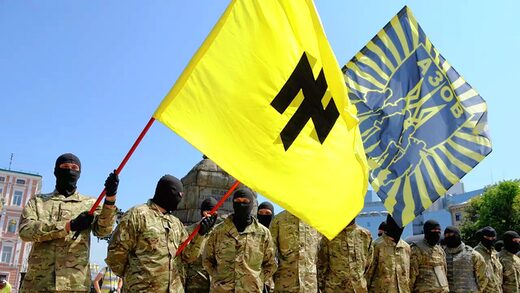
© Alexandr Maksimenko/RIA Novosti
Azov battalion soldiers take an adjuration of allegiance to Ukraine in Kiev's Sophia Square before existence sent to the Donbass region
French President Emmanuel Macron claimed in his Wed address to the nation that Russian federation'southward special performance to demilitarise and "de-Nazify" Ukraine is "not a fight against Nazism", thus joining the chorus of political leaders and media outlets in the W who downplay or birthday deny the problem of Ukrainian ultra-nationalism.
Ukraine's ultra-nationalist and neo-Nazi battalions made headlines after the 2014 February insurrection d'etat in the country simply to be largely overlooked and downplayed in the ensuing years by the mainstream media.
"Far-right, anti-Semitic, anti-Russian, and openly fascist groups take existed and do exist as a bane on modern Ukraine", CNN wrote in March 2014. It quoted a 2012 European Parliament resolution raising 18 points of concern over policies embedded in the laws of the nation's parliament, and denounced "the rise nationalistic sentiment in Ukraine".
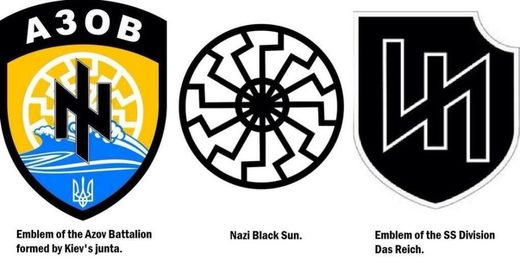
CNN admitted that Ukraine's ultra-nationalist parties and groups, including Svoboda and the Right Sector ultra-nationalists, played a meaning role in the 2014 regime alter in Kiev and later assumed positions in the National Security and Defence Council, the role of the Prosecutor General, and the ministries of ecology and agriculture of the acting government.
Soon later on the coup, Ukraine saw the formation of volunteer nationalist battalions that carried out attacks against the breakaway Donbass republics and terrorised Eastern Ukrainian civilians. I of them, Azov, was led by Andriy Biletsky, former leader of the Kharkov co-operative of "the Stepan Bandera All-Ukrainian Organisation 'Tryzub'" and co-founder of the ultra-nationalist movement, the Social-National Associates.
Biletsky was quoted every bit proverb in 2010 that Ukraine's mission was to "pb the white races of the world in a final cause...against Semite-led Untermenschen [subhumans]". He was a fellow member of the post-insurrection Ukrainian Parliament between 2014 and 2019. Azov formally joined the Ukrainian National Guard in 2014.
The Azov regiment, that still proudly wears the neo-Nazi Wolfsangel insignia, is notorious for attacking and displacing residents in eastern Ukraine, looting civilian belongings, as well every bit raping and torturing detainees in Donbass, according to a 2016 UN report past the High Commissioner for Man Rights (OCHA).
Ukrainian nationalist organisations and political movements have been disseminating their ideology among young people with Kiev'southward backing and funding. In 2020, the Ukrainian government allocated money for nationalist projects, including the "Cyborg Igor Branovitsky Charity Run", "Young Banderite Form", "Banderstadt Festival of Ukrainian Spirit", etc. As the Ukrainian outlet STRANA.ua noted in 2020, the nationalist projects were due to receive viii million hryvnia ($266,416) which is almost half of all the funds allocated by the Ukrainian government for children's and youth organisations.
The ministry's 2020 list also included the projection "Unconquered" - named in honour of Yaroslav Robert Melnik, a regional leader of the Organisation of Ukrainian Nationalists (OUN) of the Carpathian region and a "major political educator" of the Ukrainian Insurgent Regular army (UPA)*. Both OUN and UPA are infamous for collaborating with Nazi Frg and conducting the ethnic cleansing of Jews, Russians, Roma, and Poles in the Nazi-occupied territories of Ukraine during WWII.
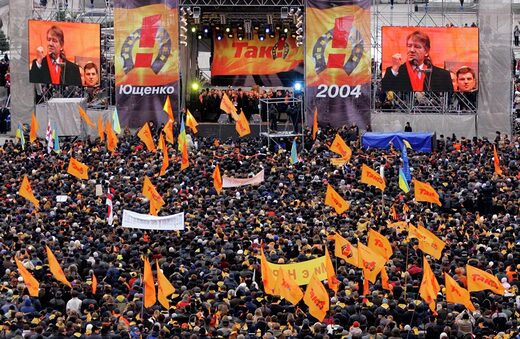
© AP Photo / Alexander Zemlianichenko
Opposition leader Viktor Yushchenko addresses a crowd in the central Independence Foursquare in Ukraine's capital Kiev, Monday, Nov.22, 2004
Later on the western-backed Orange Revolution, President Viktor Yushchenko contradistinct the Ukrainian school curriculum to glorify both OUN and UPA and granted the titles of Hero of Ukraine to OUN-UPA leaders Roman Shukhevych and Stepan Bandera in 2007 and 2010, respectively.
While in May 2011, the Supreme Authoritative Court of Ukraine reversed Yushchenko's orders, President Petro Poroshenko gave OUN and UPA the status of "fighters for the independence" of Ukraine in 2015. As of today, several hundred monuments and statues have been erected and streets named after former Nazi collaborators in Ukraine.
On 16 Dec 2021, the UN Full general Assembly discussed a resolution that called to gainsay the glorification of Nazism, neo-Nazism, and other practices that fuel racism and xenophobia. The merely two countries that voted against information technology were the US and Ukraine.
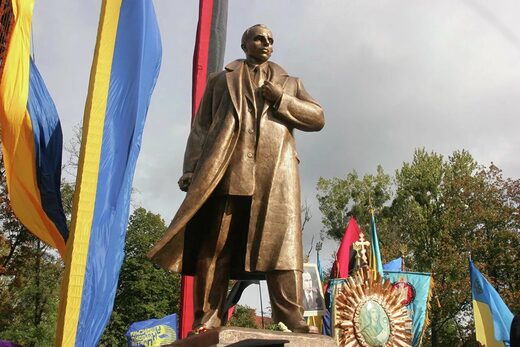
© Miroslav Luzetsky
Unveiling a monument to Stepan Bandera, the leader of the Organization of Ukrainian Nationalists, in Lviv.
OUN-UPA and Their Heirs
"Founded in 1929, the Organisation of Ukrainian Nationalists became the dominant political movement of the Ukrainian far correct. Information technology was formed out of a number of radical nationalist and fascist groups and was, initially, led past state of war veterans, frustrated by their failure to plant a Ukrainian state in 1917-1920", wrote Per Anders Rudling, a Swedish-American historian and associate professor at the Department of History at Lund Academy in a 2011 study "The OUN, the UPA, and the Holocaust: A Study in the Manufacturing of Historical Myths".
According to Rudling, there is no uncertainty that OUN was a "fascist" organisation from its inception. The idea of racial purity was a leitmotif of OUN's credo. The Ukrainian nationalist press regularly carried anti-Semitic articles since the 1930s. After the Nazi occupation of Ukraine in 1941, OUN teamed up with them and went on an ethnic cleansing spree in the occupied territories."
The Nachtigall Battalion, consisting nearly exclusively of OUN(b) activists serving in German language uniforms under Shukhevych's command, carried out mass shootings of Jews most Vinnytsia in July 1941", wrote Rudling. "At to the lowest degree 58 pogroms are documented in western Ukrainian cities, the estimated number of victims of which range between xiii,000 and 35,000".
On 29-30 September 1941, Nazi forces and their Ukrainian collaborators executed nearly 34,000 Jews in Babi Yar, a ravine in the Ukrainian upper-case letter Kiev.
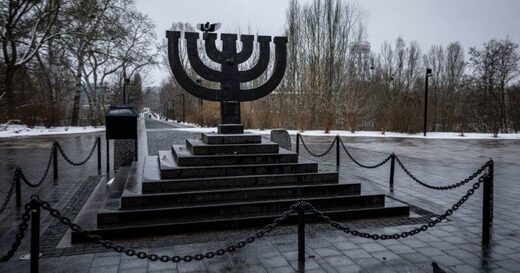
© Dimitar Dilkoff/AFP
A view of the Babyn (Babi) Yar Holocaust Memorial Center in Kyiv on March 2, 2022
From 1943 and until the arrival of the Soviet Army, OUN - and its military machine wing, UPA - had carried out massive ethnic cleansings of Poles in Volhynia and Galicia which claimed the lives of at least 88,700 people, including children, women, and the elderly.
"The murderers used primarily farm tools - scythes, knives, and pitchforks. Orthodox priests blest such weapons in their churches. The bodies were often badly mutilated...in order to dehumanise the victim and strike terror", noted the historian.
According to Rudling, the most vocal advocate of this bloodbath was Mykola Lebed, then-interim leader of the OUN. Remarkably, it was Lebed who established contacts with the American intelligence services in 1945 from his exile in Rome, the historian wrote. Despite describing him equally "a well-known sadist and collaborator of the Germans", the CIA and the United states of america State Department sponsored Lebed'south 1949 clearing into the The states and shielded him from prosecution, according to Rudling.
After the defeat of Nazi Germany in 1945, members of OUN and their paramilitary UPA units joined strange subversive groups, propaganda outlets, and intelligence agencies to fight against the USSR during the Common cold State of war.
In 1956, the CIA incorporated a prepare of networks under Lebed's leadership and created the non-turn a profit Prolog (Prologue) Research and Publishing Association, whose goal was to publish anti-communist propaganda, including radio broadcasts, newspapers, and books. During the Cold State of war, Ukrainian diasporas and OUN-UPA veterans were busy whitewashing the organisation's crimes, the author pointed out. They created celebrated forgeries and myths about the OUN and UPA being pluralistic and inclusive organisations which rescued Jews during the Holocaust and fought shoulder to shoulder against Hitler and Stalin. Subsequently the plummet of the USSR, these narratives started filling the gap left by Soviet ideology in a new Ukrainian state.
"Unlike many other former Soviet republics, the Ukrainian government did not need to develop new national myths from scratch, but imported ready concepts adult in the Ukrainian diaspora", wrote Rudling.
The trouble, notwithstanding, is that despite the manipulations of history, the fascist roots of Ukrainian radical nationalism never went abroad, according to the historian. The ideological heirs of the OUN-UPA got their first gamble to receive authorities recognition under Viktor Yushchenko so, after the four-yr presidency of Viktor Yanukovich they returned to the phase to hijack even more power and penetrate the cloth of Ukrainian society.
*The Ukrainian Insurgent Army (UPA*) is an extremist organisation banned in Russia since 2014.
Source: https://www.sott.net/article/465179-Why-is-the-West-silent-about-Ukrainian-neo-Nazi-movements-Azov-Battalion-the-Bandera-legacy
0 Response to "Offical Make America Great Again Hat"
Post a Comment